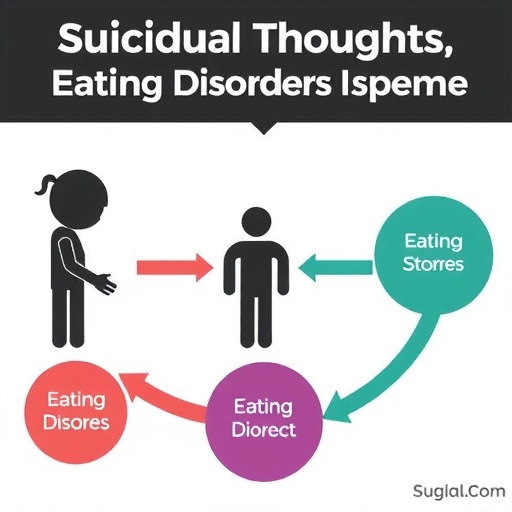In recent years, the complex interplay between mental health disorders and traumatic experiences has garnered increasing attention within psychiatric research. A groundbreaking study published in BMC Psychiatry delves deeply into the intricate relationship connecting suicidal ideation, eating disorders (EDs), and experiences of violence. By examining these factors together, researchers aimed to uncover patterns and causative links that could transform our understanding of mental health vulnerabilities under the shadow of violence.
This extensive cross-sectional study encompassed 935 participants aged between 18 and 40 years, offering a broad glimpse into the demographic most affected by these intertwined issues. The research utilized several validated instruments, including the Suicide Probability Scale (SPS), the Eating Disorder Evaluation Scale short form (EDE-Q-13), and the Violence Experiences Questionnaire-Revised (VEQ-R), providing a multifaceted assessment of participants’ psychological states and lived experiences.
One of the study’s most striking findings was the nuanced association between sociodemographic factors and suicidal ideation. Contrary to conventional assumptions, higher education and economic standings correlated with elevated SPS scores, suggesting that suicidal thoughts are not confined to socioeconomically disadvantaged groups. Additionally, single participants, smokers, and those using substances displayed increased suicide probability, indicating lifestyle factors and social support systems play critical roles in mental health outcomes.
Eating disorders showed distinct patterns across gender and body mass index categories. Females alongside overweight and obese participants scored significantly higher on the EDE-Q-13 metric, highlighting how body image challenges and gender-specific pressures converge to influence disordered eating behaviors. This raises compelling questions about how cultural and biological factors affect susceptibility to EDs in different populations.
Violence experiences emerged as a critical variable influencing both suicidal ideation and eating disorders. Participants with lower economic status, who smoked or used substances, reported higher VEQ-R scores, emphasizing the compound effect of socioeconomic hardship and harmful coping behaviors on exposure to violence. Such violence, particularly when rooted in childhood, appears to inflict long-lasting psychological trauma with reverberations into adulthood.
Perhaps most importantly, the study revealed that while violence experiences, eating disorders, and suicidal ideation were all statistically positively correlated, these relationships were relatively weak in isolation. Nevertheless, multiple regression analyses showed that both ED symptoms and exposure to violence independently contributed to suicide probability. This suggests a complex, perhaps synergistic, mechanism underpinning mental health risks, rather than a simple linear causality.
The research also illuminated familial factors influencing mental health outcomes. Participants from divorced families or with histories of chronic illness displayed higher median EDE-Q-13 scores, implicating family dynamics and health stressors as potential aggravators of eating disorder symptomatology. Similarly, VEQ-R scores were elevated among those with divorced parents, deceased parents, or fathers, pointing to the profound psychological impact of disrupted parental bonds.
These findings collectively underscore the pivotal role of childhood violence and trauma as both direct and indirect enhancers of mental health disorders, particularly eating disorders and suicidal ideation. The persistence of these conditions into adulthood highlights the necessity for early intervention strategies that address trauma comprehensively, rather than targeting symptoms in isolation.
Moreover, the apparent correlation between EDs and suicidal ideation, which may occur independently of violence experiences, suggests that clinicians should maintain vigilance for overlapping psychopathologies even in the absence of trauma history. This layered understanding challenges simplistic diagnostic frameworks and calls for more holistic, integrated therapeutic approaches.
The study’s methodological rigor and sizable sample contribute to its potential as a landmark in psychiatric research. By leveraging validated scales for suicide risk, eating disorder evaluation, and violence exposure, the authors provide robust evidence that can inform preventive strategies, clinical assessments, and policy-making efforts.
In conclusion, this investigation elucidates the multifactorial nature of mental health risks associated with violence and eating pathology. It advocates for a paradigm shift that recognizes the interplay between personal, familial, and societal domains in shaping psychological well-being. The implications for public health are profound, calling for enhanced support systems, trauma-informed care, and proactive outreach to vulnerable populations.
As mental health crises continue to surge globally, understanding the subtle and overt connections between suicidal tendencies and eating disorders—especially through the lens of violence—is more critical than ever. Future research expanding on these findings could pave the way for more targeted interventions, ultimately reducing the burden of these devastating conditions on individuals and communities alike.
Subject of Research: The investigation centers on exploring the relationship between suicidal ideation and eating disorders within the framework of violence experiences, with a focus on demographic, familial, and behavioral correlates.
Article Title: The relationship between suicidal ideation and eating disorders in the context of violence experiences
Article References:
Durmuş, H., Borlu, A., Arslan, Ş. et al. The relationship between suicidal ideation and eating disorders in the context of violence experiences. BMC Psychiatry 25, 547 (2025). https://doi.org/10.1186/s12888-025-07001-0
Image Credits: AI Generated




